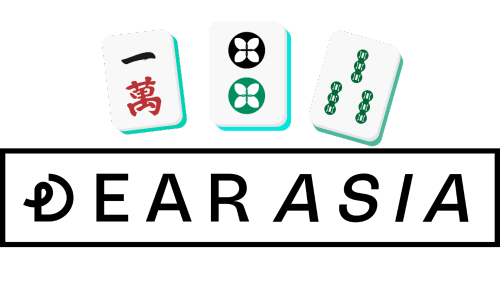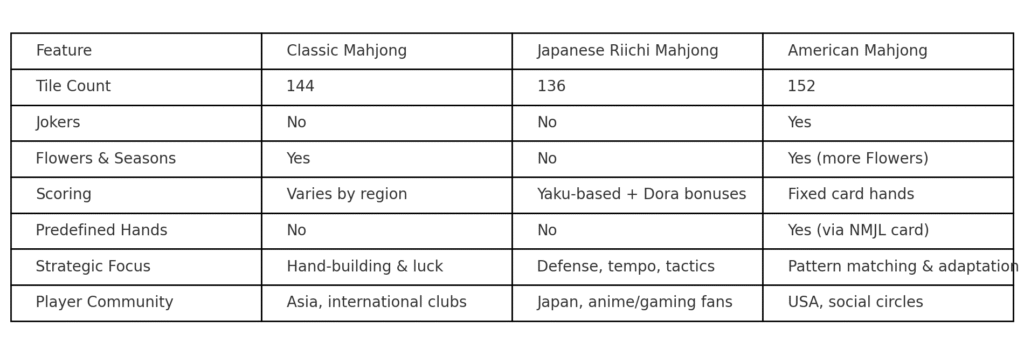When you’re just starting to learn Mahjong, it’s easy to feel overwhelmed. You might search for “learn Mahjong online” or “online Mahjong games”, or maybe you’ve joined a local group and found yourself being asked or asking the inevitable first question:
“What style of Mahjong do you play?”
If that sounds familiar — you’re not alone. Many beginners don’t even realize there are different styles of Mahjong, let alone which one they should learn to play. That’s exactly why we’re writing this blog series: to give you a clear, beginner-friendly breakdown of the three main types of Mahjong you’re most likely to come across – Classic Chinese Mahjong, Japanese Riichi Mahjong, and American Mahjong.
As a Mahjong school, we’re proud to say:
✅ We teach all three styles — but mainly Classic Chinese Mahjong with Hong Kong or British scoring, as they are the most popular styles here in the UK.
However, let’s dive into the 3 main styles separately, and explore their similarities and differences to help you find your starting point.
#mahjong_dearasia
We know learning Mahjong on your own is hard—and not very fun. Dear Asia is the Mahjong school you’ve been looking for. Based in London, book tickets for our regular Saturday workshops below or hire our private Mahjong instructors.

1. Chinese Classic Mahjong (with variants)
Mahjong originated in China in the 19th century, and its core gameplay — forming a hand from drawn and discarded tiles — remains the foundation across all styles.
As Mahjong spread beyond China, different regions adapted the game to suit their own styles. While the core tiles and rules stayed consistent, each culture developed its own way of scoring hands, often redefining what counts as a “big” or “small” win. Some introduced bonus points, special hand patterns, or simplified the system to speed up play.
That’s why in our Newbie Workshop, you’ll start by learning the classic foundations of Mahjong. Then, in our Improver Workshops, you can choose to explore different regional styles — each with its own unique scoring system and strategy.
Foundation of the Game
All forms of Mahjong stem from the classic Chinese ruleset, where players aim to build a winning hand (usually 4 sets and a pair) by drawing and discarding tiles.
Tile Set
144 tiles including suits (Dots, Bamboo, Characters), Honor tiles (Winds and Dragons), and bonus tiles (Flowers and Seasons).
Regional Variants
- Hong Kong Mahjong: this is the most popular and beginner-friendly version, using a simple “fan” (doubling) scoring system where rare hands earn more points. It’s the go-to style in most Chinese community centers and social games, making it a great starting point for learners who want to connect with traditional Chinese play.
- British Mahjong: is quite similar to Hong Kong Mahjong in its use of doubling points, but its scoring system uniquely distinguishes between major tiles (1s, 9s, and honor tiles) and minor tiles (2s through 8s), awarding different points accordingly. The game also features special hands that are truly exceptional—so much so that only very advanced players or those competing in international tournament styles typically attempt to build them. This adds an extra layer of challenge and strategy to British Mahjong. While there are local British Mahjong groups playing this style, and we can teach British scoring rules, Hong Kong style remains much more widely played in London.
- Chinese International Mahjong: Chinese International Mahjong is a formalized version of the game used in official tournaments, featuring a standardized set of rules designed to balance skill and fairness at the highest competitive levels. However, despite its prominence in international play, these complex rules are rarely followed by families across China in everyday life. Instead, most players prefer regional Mahjong styles, which often have faster-paced gameplay and simpler winning conditions, making them more popular and accessible for casual and social play.
- Chinese Regional Mahjong: Chinese regional Mahjong varies widely across the country, with each area having its own popular version. The most well-known is Cantonese Mahjong, played primarily in the Guangdong region and nearly identical to Hong Kong Mahjong in rules and style. Other notable variants include Sichuan Mahjong, known for its fast pace and unique local rules, and Northeast Mahjong, which features distinctive tile sets and scoring systems.
2. Japanese riichi Mahjong
Japanese Riichi Mahjong was once mostly popular among online gaming communities, which is why many popular Mahjong apps and websites focus on Riichi. Traditionally, the game was seen as something older generations, like grandparents, played. However, in recent years, it has become more popular among younger people in Japan, changing its image into a trendy and strategic game enjoyed by all ages.
This growing popularity has sparked international interest, with more players worldwide eager to learn Riichi Mahjong. As a result, international tournaments are now regularly organized, reflecting the game’s expanding global community.
Tactical Depth with a Poker-like Style
Developed from the Chinese game during the 20th century, Riichi Mahjong is arguably the most strategic version. It’s widely played in Japan and among anime fans and competitive players worldwide.
Tile set
- 136 tiles (no flowers or seasons)
- Standard suits and honor tiles only
Key Features
- Riichi declaration: A player can declare “Riichi” when they’re one tile away from winning, locking their hand and betting on success.
- Dora (bonus tiles): Hidden bonus tiles add strategic tension and boost scores.
- Furiten and Yaku: Strict rules about valid winning hands and scoring conditions.
- Heavy emphasis on reading opponents, defense, and probability.
- Fixed point system with yaku-based scoring (must meet a minimum hand value to win).
3. American Mahjong
Popular especially among communities in the United States, American Mahjong evolved into a very different game. It incorporates elements of Rummy and is played according to an annually updated card from the National Mah Jongg League (NMJL).
A Rummy-Inspired, Card-Guided Twist
American Mahjong offers a unique twist inspired by Rummy, using special hands and card guides to shape gameplay. Unlike traditional Mahjong versions, players rely on annually updated cards that list winning hand combinations, making it a more structured and strategic experience. This card-guided system helps players focus on building specific sets, adding clarity and excitement to the game.
Tile set
- 152 tiles, including 8 jokers and 8 flowers (no season or flower difference)
- Normally seen with racks for tile management
Key Features
- Hands are not built freely: Players choose from a predefined list of valid hands (published annually).
- Jokers can substitute for most tiles.
- Charleston: A distinctive tile-passing phase at the beginning of each game.
- Much more focused on pattern recognition and adaptation than on probability and discard tracking.
- Less emphasis on reading opponents
A Simple Chart to See the Difference

So, which mahjong style should you learn first?
Here’s a quick cheat sheet:
| Your Style | Best Mahjong Match |
|---|---|
| Total beginner, also enjoy a cultural intro | Classic Mahjong with Hong Kong or British rules |
| Gamer mindset, love strategy | Japanese Riichi Mahjong |
| Casual, social, or puzzle lover or living in America | American Mahjong |
And remember — you don’t have to pick just one. Many of our students go on to learn different styles, and that’s the beauty of Mahjong: it’s endlessly rich and always evolving.
Want to hire us?
London Mahjong Instructors
Our Mahjong instructors are professional teachers who know how to teach anyone to play—quickly, practically, and in a fun, social way. Read our reviews to see how well we do. Book us for your event—we’ve worked with celebrities, film sets, and large corporate functions!








